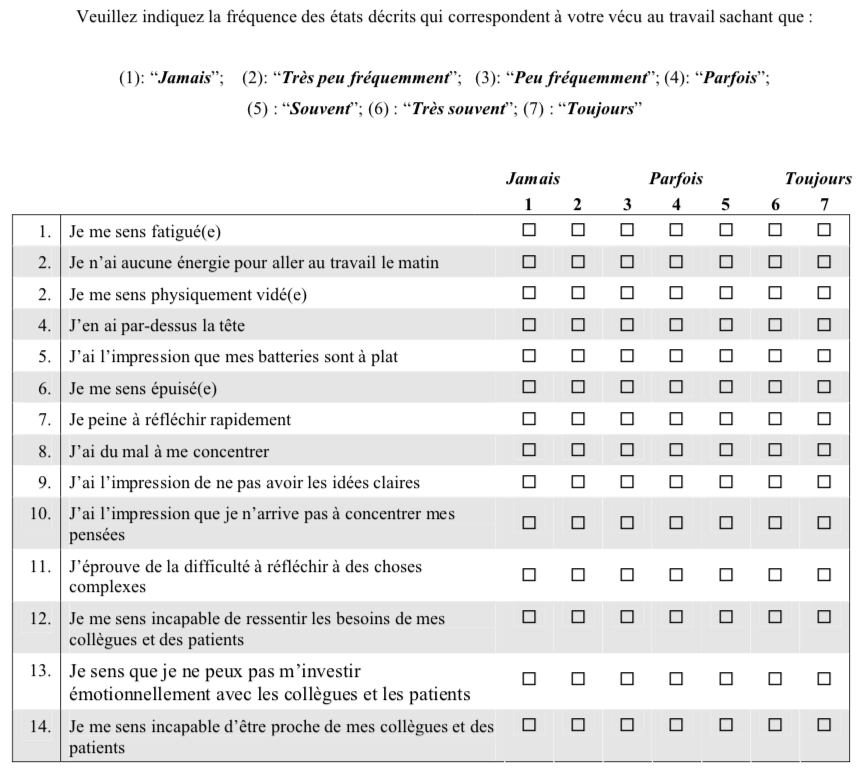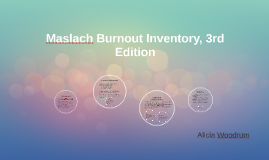

Age differences in allostatic load: An index of physiological dysregulation. M., Johnston, M., Hayward, M., & Seeman, T. Occupational and Environmental Medicine, 60 (Suppl.
#Maslach burnout inventory test how to
How to conduct research on burnout: Advantages and disadvantages of a unidimensional approach to burnout. Anxiety, Stress and Coping, 15, 245–260.īrenninkmeijer, V., & Van Yperen, N. Validation of the Maslach Burnout Inventory-General Survey: An internet study.

Behavioral Medicine, 17, 53–59.īakker, A. Burnout as a risk factor for coronary heart disease. International Journal of Cardiology, 17, 15–24.Īppels, A., & Schouten, E. A questionnaire to assess premonitory symptoms of myocardial infarction. The mediating physiological mechanisms between burnout and objective physical health remain to be elucidated.Īppels, A., Hoppener, P., & Mulder, P. Conclusion: Burnout seems not to be associated with this proxy measure of allostatic load. An additional analysis, using groups of managers in the extreme deciles of exhaustion (the core symptom of burnout), did also not reveal differences in allostatic load. Results: Contrary to expectations, burned-out managers did not differ from healthy managers with regard to their scores on the allostatic load index. The allostatic load index included eight parameters: Body-mass index (BMI), systolic and diastolic blood pressure (SBP and DBP), C-reactive protein (CRP), high-density lipoprotein (HDL), cholesterol, glycosylated hemoglobin (HbA1C) and glucose. Method: Burned-out managers, as identified with the Maslach Burnout Inventory General Survey (MBI-GS), were compared with a healthy control group with regard to their allostatic load. Goal: The aim of the present study among 290 Dutch managers was to explore whether allostatic load mediates the relationship between burnout and physical health. To elucidate these mechanisms, possible mediating physiological systems or risk factors for adverse health in burned-out employees should be investigated. Nursing Identifiers URN: urn:nbn:se:hj:diva-55897 DOI: 10.1016/j.08868 ISI: 000767225100033 PubMedID: 35169645 Scopus ID: 2-s2.0-85123927287 Local ID: GOA intsam 796258 OAI: oai:DiVA.Background: Burnout has a negative impact on physical health, but the mechanisms underlying this relation remain unclear. 8, no 2, article id e08868īurnout, Factor analysis, Nurse, Physician, Validation National Category Place, publisher, year, edition, pagesElsevier, 2022. Conclusion: The MBI-HSS-MP has good psychometric properties to assess burnout accurately among healthcare professionals in the three dimensions of emotional exhaustion, personal accomplishment, and depersonalization. Test-retest reliability of each MBI-HSS-MP item was satisfactory and no substantial DIF items were displayed across gender or across health professionals. Results: The MBI-HSS-MP was verified as having a three-factor structure and each item was embedded well in its belonging construct (comparative fit index = 0.941, Tucker-Lewis index = 0.929 derived from CFA results infit and outfit MnSq = 0.71 to 1.38 derived from Rasch models). The psychometric properties of the 22-item MBI-HSS-MP was then examined for its factor structure via confirmatory factor analysis (CFA) and Rasch models, test-retest reliability, item fit, and differential item functioning (DIF). Health professionals of physicians (n = 106) and nurses (n = 200) participated in the study. Methods: The study setting was all eight hospitals in Qazvin province, Iran (study period from 10 September to 16 November 2020). The specific aims were to psychometrically assess the Persian MBI-HSS-MP in relation to its structure, test-retest reliability, and item properties. 8, no 2, article id e08868 Article in journal (Refereed) Published Abstract īackground: This study aimed to validate the Persian version of Maslach Burnout Inventory for Medical Personnel (MBI-HSS-MP), an instrument developed to capture burnout for health professionals.


 0 kommentar(er)
0 kommentar(er)
